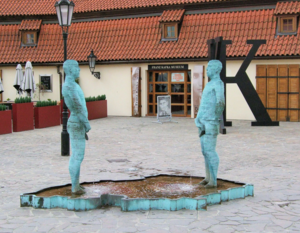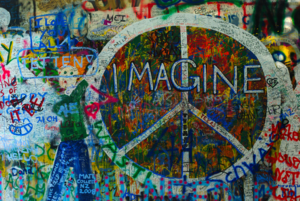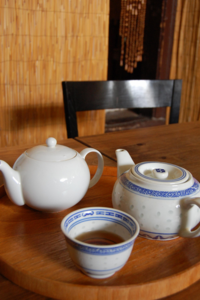

Prague is the historical capital of the Bohemia region, and is one of the most visited destinations in Europe. With its prevalence of beer, historical monuments, curious architecture and nightlife, the historic centre of Prague rightfully carries the title of UNESCO World Heritage site.
There is so much more to be seen, done and tasted in this city, aside from the usual tourist hotspots. If you’re coming back to visit Prague again and want to see another side of this magical place, or you’re simply one of those people who don’t fancy the big tourist crowds, have a read and see if you are tempted by the alternative Prague.
There are a few spots in Prague that have often been described as controversial: making some people laugh and others criticise, they create a curious contemporary art scene in the Czech capital. The well-known statue of King Wenceslas has it’s own comical version in the Lucerna shopping passage, which is near the Wenceslas square. The statue by the leading contemporary Czech artist David Černý, named "Kůň" (Horse), has put the king on the dead horse’s belly which is upside down with it’s tongue out, altogether hanging from the ceiling.

Another entertaining work by Černý is the huge babies (or aliens), known as “Miminka” crawling up the Žižkov TV tower. Another bold modern art piece stands outside the Kafka Museum, called “Proudy” (Piss), illustrating two men peeing out famous quotes into a pond shaped into the Czech republic contour. Curiously, if you send a text message to the number indicated beside them, the men will interrupt their activity to spell out your message in the water.
Černý has also hung up a Sigmund Freud look-a-like man named “Viselec” (Man Hanging Out) on the corner of Skořepka and Husova street. If you spot many similar installations around Prague that seem out of place, whilst at the same time perfectly oddly fitting the scene, chances are - they’re probably Černý’s work.
One of Prague’s most enjoyed specialties is its world-renowned beer. This may explain why the Czechs drink more beer per capita than any other nation. In addition, Prague citizens drink more than the rest of the country put together. In order to get the most of Prague beer exploration, it is recommended you avoid the most central pubs, which often happen to be overpriced and full of tourists. Many pubs brew their own beer, in addition to offering numerous Czech and international beer brands. Have a stroll around the Žižkov area, where you will encounter an endless number of bars and pubs, accompanied by a real local atmosphere.

The Lennon Wall may not be so off the beaten track any longer, but it is still worth a visit. It is considered an inspiration that combines history and art. Originally the wall was used by students as a canvas to express their dissatisfaction with the repressive communist regime, which often lead to the police getting involved. John Lennon’s face can still be seen all over the wall, accompanied by locals’ and tourists’ messages of longings and dreams.
The Prague Museum of Communism depicts the lifestyle under the Communist regime through genuine artifacts, multimedia films, informative texts and art. The distress over that period of time is captured through six sculptures of a man who is in progressive decay. The museum refers to Communism as the Dream, the Reality, and the Nightmare, also standing as a memorial to the victims of that time.
Prague’s nightlife offers a bit of something for every taste. There are a few curiously eccentric places that deserve special attention.
One of these is a restaurant-bar called Pravěk , which has a neanderthal theme: all the staff are dressed up as cavemen and women and you have to bang a rock placed on each table in order to get service. The menu offers meals and drinks with a Prehistoric theme. Parties can be booked and special events are organised by the place, meeting the shaman and his band for example.
Another curious place is Krákora , which seems to be in the middle of nowhere, but it gets a lot of customers - because of the good beer and food, cheap prices, and the pumas walking around the garden. Yes, pumas. They’re often taken for a walk in the park close by.
Cross Club is another spot worth a visiting: the club is at the heart of the alternative culture. It is a crossroad of styles and genres, with a focus on unconventional music genres. The club is also a venue for alternative film screenings, authors reading their works, young theatre companies and afternoon theatre performances for kids. The place is a mix of everything, with a fantastic futuristic interior.

Prague has numerous tea rooms and as tea is highly appreciated in the Czech Republic it is a must at least once. Czech tea rooms tend to provide a relaxed and casual atmosphere, extended tea menus, soft lighting and ambient chillout music. The majority of these tea rooms are non-smoking, however some offer shishas, like Čajovna Šiva (Praha Masná 8). A few other recommendations include Čajovna v Siti (Jana Masaryka 46), Čajovna ve Věži (Na Výšinách 1). Some places offer lectures on tea, over 100 types of tea and have books available for literature lovers.
The best advice you can be given if you want to explore Prague’s not so commercialised face is to put your city map away in your pocket and walk around areas that are not crammed with people with cameras, and where you can hear English speech. Get lost and dig in!